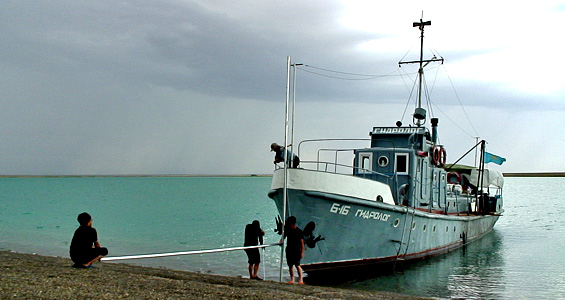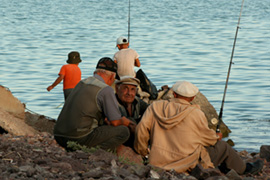Central Asian lake under threat
Lake Balkhash, the region’s second largest, may slowly die because of reduced inflow.

 |
| Kazakhstan’s Lake Balkhash appears to have shrunk by two metres in just five years |
“How is the lake?” ask the team of scientists as they loaded their equipment onto the research ship.
The skipper’s face looks grim. His response: a downward motion of his hand.
Keep reading
list of 4 itemsAfter the Hurricane
World’s coral reefs face global bleaching crisis
Why is Germany maintaining economic ties with China?
The people of Lake Balkhash are worried. Little by little, their pearl of southern Kazakhstan appears to be diminishing.
| In video | ||
|
I travelled with a team of scientists on board the research vessel, appropriately named Hydrologist, to chart the waters of one of the largest continental lakes in the world.
Using techniques such as sedimentary and seismic analysis, the researchers are looking to distinguish both human and climatic impacts on the lake over thousands of years.
Balkhash is partially saline and comparatively shallow at around six metres deep on average. Given its large surface area of 18,000sq km, it is extremely sensitive to reduced inflow of fresh water which is vital to balance the effects of evaporation.
Stretching for over 500km in an east-west arc, the lake is home to hundreds of bird and fish species.
Upstream extraction
Balkhash belongs to a string of lakes which play an important role in helping to regulate Kazakhstan’s largely arid climate.
It is the end point of a river system known as the Ile Balkhash Basin that is home to more than three million people.
The Ile river is fed by rainfall, snow and glacial melt from the mountain ranges which straddle China, Kazakhstan and Kyrgyzstan.
|
“China, Kyrgyzstan and Kazakhstan agreed on the management of the lake, but it has been just theatrical” Renato Sala, |
Without Balkhash, warns Renato Salo from the Laboratory of Geoarchaelogy in Almaty, desertification could follow.
“This water is moisturising the climate, so the climate would change of course,” Sala says.
One stormy afternoon, we took shelter in a small inlet. Diminishing annual high water marks have formed a ripple effect on the black shingle.
The drop appears to show that the lake has receded by up to two metres in the past five years. And in shallow areas of the lake, that regression could be even greater.
The UN acknowledged in 2004 that Balkhash was threatened by upstream extraction of water in Kazakhstan and China, largely for irrigation.
China is developing the region of Xinjiang, which borders Kazakhstan. Tens of thousands of Chinese have been resettled and new dams are being built.
International initiatives do exist to try to encourage sustainable use of water resources on the Ile Balkhash Basin.
Another Aral Sea?
But Sala says they have failed to achieve much.
“The European Commission promoted an international conference with China, Kyrgyzstan and Kazakhstan to agree on the management of the lake, but it has been just theatrical,” Salo said.
“It didn’t have any following steps.”
A legal specialist who consults with the Chinese and the Kazakhs – but who asked not to be named – criticised the lack of binding agreements, despite regular consultations between both sides.
 |
| The three million residents of the Ile Balkhash Basin fear their lake is disappearing |
“There’s a need to introduce an integrated river basin water management which requires a much higher degree of collaboration between all interested parties. It’s not clear at the moment whether there has been any progress in terms of attaining these overall objectives,” the legal specialist said.
Central Asia has already experienced catastrophic loss of a water system. The Aral Sea is considered one of the greatest environmental tragedies of the 20th Century.
Soviet irrigation led to its irreversible decline. Even today, vast quantities of water are drawn from the rivers that feed it and used for cotton cultivation by Kazakhstan and its neighbours, Uzbekistan and Turkmenistan.
The Aral Sea is now a tenth of its original size. Where there was once water, there is now desert.
Fertiliser and pesticide residues have contaminated the local population, and salt particles are believed to accelerate glacial melting in mountains thousands of kilometres away.
Scientific evidence looks certain to demonstrate that the same conditions of unsustainable water use that destroyed the Aral now threaten Balkhash.
What is less clear is whether it will be enough to persuade the Chinese and the Kazakhs to co-operate and compromise in order to ensure the lake’s survival.
